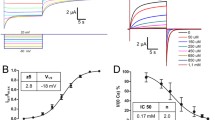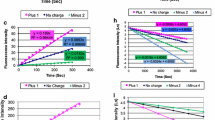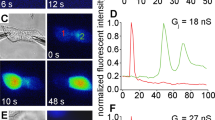Abstract
Connexin45 (Cx45) hemichannels (HCs) open in the absence of Ca2+ and close in its presence. To elucidate the underlying mechanisms, we examined the role of extra- and intracellular Ca2+ on the electrical properties of HCs. Experiments were performed on HeLa cells expressing Cx45 using electrical (voltage clamp) and optical (Ca2+ imaging) methods. HCs exhibit a time- and voltage-dependent current (I hc), activating with depolarization and inactivating with hyperpolarization. Elevation of [Ca2+]o from 20 nM to 2 μM reversibly decreases I hc, decelerates its rate of activation, and accelerates its deactivation. Our data suggest that [Ca2+]o modifies the channel properties by adhering to anionic sites in the channel lumen and/or its outer vestibule. In this way, it blocks the channel pore and reversibly lowers I hc and modifies its kinetics. Rapid lowering of [Ca2+]o from 2 mM to 20 nM, achieved early during a depolarizing pulse, led to an outward I hc that developed with virtually no delay and grew exponentially in time paralleled by unaffected [Ca2+]i. A step increase of [Ca2+]i evoked by photorelease of Ca2+ early during a depolarizing pulse led to a transient decrease of I hc superimposed on a growing outward I hc; a step decrease of [Ca2+]i elicited by photoactivation of a Ca2+ scavenger provoked a transient increase in I hc. Hence, it is tempting to assume that Ca2+ exerts a direct effect on Cx45 hemichannels.





Similar content being viewed by others
References
Bader P, Weingart R (2004) Conductive and kinetic properties of connexin45 hemichannels expressed in transfected HeLa cells. J Membr Biol 199:143–154
Bader P, Weingart R (2006) Pitfalls when examining gap junction hemichannels: interference from volume-regulated anion channels. Pflügers Arch 453:396–406
Beahm DL, Hall JE (2002) Hemichannel and junctional properties of connexin 50. Biophys J 82:2016–2031
Bukauskas FF, Bukauskiene A, Verselis VK, Bennett MVL (2002) Coupling asymmetry of heterotypic connexin 45/connexin 43-EGFP gap junctions: properties of fast and slow gating mechanisms. PNAS (USA) 99:7113–7118
Bukauskas FF, Elfgang C, Willecke K, Weingart R (1995) Biophysical properties of gap junction channels formed by mouse connexin40 in induced pairs of transfected human HeLa cells. Biophys J 68:2289–2298
Bukauskas FF, Verselis VK (2004) Gap junction channel gating. Biochim Biophys Acta 1662:42–60
Butterweck A, Gergs U, Elfgang C, Willecke K, Traub O (1994) Immunochemical characterization of the gap junction protein connexin45 in mouse kidney and transfected human HeLa cells. J Membr Biol 141:247–256
Délèze J (1970) The recovery of resting potential and input resistance in sheep heart injured by knife of laser. J Physiol 208:547–562
Derouette J-P, Desplantez T, Wong CW, Roth I, Kwak BR, Weingart R (2009) Functional differences between human Cx37 polymorphic hemichannels. J Mol Cell Cardiol 46:499–507
Ebihara L, Liu X, Pal JD (2003) Effect of external magnesium and calcium on human connexin46 hemichannels. Biophys J 84:277–286
Ebihara L, Steiner E (1993) Properties of a nonjunctional current expressed from a rat connexin46 cDNA in Xenopus oocytes. J Gen Physiol 102:59–74
Elfgang C, Eckert R, Lichtenberg-Fraté H, Butterweck A, Traub O, Klein RA, Hülser DF, Willecke K (1995) Specific permeability and selective formation of gap junction channels in connexin-transfected HeLa cells. J Cell Biol 129:805–817
Firek L, Weingart R (1995) Modification of gap junction conductance by divalent cations and protons in neonatal rat heart cells. J Mol Cell Cardiol 27:1633–1643
Gomes P, Srinivas SP, Vereecke J, Himpens B (2006) Gap junctional intercellular communication in bovine corneal endothelial cells. Exp Eye Res 83:1225–1237
Gómez-Hernández JM, de Miguel M, Larrosa B, Gonzáles D, Barrio LC (2003) Molecular basis of calcium regulation in connexin-32 hemichannels. Proc Natl Acad Sci U S A 100:16030–16035
Haefliger JA, Nicod P, Meda P (2004) Contribution of connexins to the function of the vascular wall. Cardiovasc Res 62:345–356
Harris AL (2001) Emerging issues of connexin channels: biophysics fills the gap. Quart Rev Biophys 34:325–472
Harris AL, Spray DC, Bennett MVL (1981) Kinetic properties of a voltage-dependent junctional conductance. J Gen Physiol 77:95–117
Kronengold J, Trexler EB, Bukauskas FF, Bargiello TA, Verselis VK (2003) Single-channel SCAM identifies pore-lining residues in the first extracellular loop and first transmembrane domains of Cx46 hemichannels. J Gen Physiol 122:389–405
Lurtz MM, Louis CF (2003) Intracellular calcium regulation of connexin43. Am J Physiol Cell Physiol 293:C1806–C1813
Noma A, Tsuboi N (1987) Dependence of junctional conductance on proton, calcium and magnesium in cardiac paired cells of guinea-pig. J Physiol 382:193–211
Paullauskas N, Pranevicius M, Pranevicius H, Bukauskas FF (2009) A stochastic four-state model of contingent gating of gap junction channels containing two ‘fast’ gates sensitive to transjunctional voltage. Biophys J 96:3936–3948
Pfahnl A, Dahl G (1999) Gating of Cx46 gap junction hemichannels by calcium and voltage. Pflügers Arch 437:345–353
Puljung MC, Berthoud VM, Beyer EC, Hanck DA (2004) Polyvalent cations constitute the voltage gating particle in human connexin37 hemichannels. J Gen Physiol 124:587–603
Rose B, Loewenstein WR (1975) Permeability of cell junction depends on local cytoplasmic calcium activity. Nature 254:250–252
Rozental R, Srinivas M, Gokhan S, Urban M, Dermietzel R, Kessler JA, Spray DC, Mehler MF (2000) Temporal expression of neuronal connexins during hippocampal ontogeny. Brain Res Brain Res Rev 32:57–71
Sáez JC, Connor JA, Spray DC, Bennett MVL (1989) Hepatocyte gap junctions are permeable to the second messenger, inositol 1,4,5-trisphosphate, and the calcium ion. Proc Natl Acad Sci U S A 86:2708–2712
Sáez JC, Retamal MA, Basilio D, Bukauskas FF, Bennett MVL (2005) Connexin-based gap junction hemichannels: gating mechanisms. Biochim Biophys Acta 1711:215–224
Scemes E, Giaume C (2006) Astrocyte calcium waves: what they are and what they do. Glia 54:716–725
Severs NJ, Coppen SR, Dupont E, Yeh HI, Ko YS, Matsushita T (2004) Gap junction alterations in human cardiac disease. Cardiovasc Res 62:368–377
Sohl G, Guldenagel M, Traub O, Willecke K (2000) Connexin expression in the retina. Brain Res Brain Res Rev 32:138–145
Spray DC, Stern JH, Harris AL, Bennett MVL (1982) Gap junction conductance: comparison of sensitivities to H and Ca ions. Proc Natl Acad Sci U S A 79:441–445
Spray DC, Ye Z-C, Ransom BR (2006) Functional connexin “hemichannels”: a critical appraisal. Glia 64:758–773
Stout CE, Costantin JL, Naus CCG, Charles AC (2002) Intercellular calcium signaling in astrocytes via ATP release through connexin hemichannels. J Biol Chem 277:10482–10488
Thimm J, Mechler A, Lin H, Rhee S, Lal R (2005) Calcium-dependent open/closed conformations and interfacial energy maps of reconstituted hemichannels. J Biol Chem 280:10646
Tong J-J, Ebihara L (2006) Structural determinants for the differences in voltage gating of chicken Cx56 and Cx45.6 gap-junctional hemichannels. Biophys J 91:2142–2154
Trexler EB, Bennett MVL, Bargiello TA, Verselis VK (1996) Voltage gating and permeation in a gap junction hemichannel. Proc Natl Acad Sci U S A 93:5836–5841
Trexler EB, Bukauskas FF, Kronengold J, Bargiello TA, Verselis VK (2000) The first extracellular loop domain is a major determinant of charge selectivity in connexin46 channels. Biophys J 79:3036–3051
Valiunas V (2002) Biophysical properties of connexion-45 gap junction hemichannels studied in vertebrate cells. J Gen Physiol 119:147–164
Valiunas V, Mui R, McLachlan E, Valdimarsson G, Brink PR, White TW (2004) Biophysical characterization of zebrafish connexin35 hemichannels. Am J Physiol Cell Physiol 287:C1596–C1604
Verselis VK, Srinivas M (2008) Divalent cations regulate connexin hemichannels by modulating intrinsic voltage-dependent gating. J Gen Physiol 132:315–327
Verselis VK, Trelles MP, Rubinos C, Bargiello TA, Srinivas M (2009) Loop gating of connexin hemichannels involves movement of pore-lining residues in the first extracellular loop domain. J Biol Chem 284:4484–4493
Vogel R, Weingart R (1998) Mathematical model of vertebrate gap junctions derived from electrical measurements on homotypic and heterotypic channels. J Physiol 510(1):177–189
Warn-Cramer BJ, Lau AF (2004) Regulation of gap junctions by tyrosine protein kinases. Biochim Biophys Acta 1662:81–95
Weingart R (1977) The actions of ouabain on intercellular coupling and conduction velocity in mammalian ventricular muscle. J Physiol 264:341–365
Wong CW, Christen T, Roth I, Chadjichristos CE, Derouette J-P, Foglia BF, Chanson M, Goodenough DA, Kwak BR (2006) Connexin37 protects against atherosclerosis by regulating monocyte adhesion. Nat Med 12:950–954
Zhou Y, Yang W, Lurtz MM, Ye Y, Huang Y, Lee H-W, Chen Y, Louis CF, Yang JJ (2007) Identification of the calmodulin binding domain of connexin 43. J Biol Chem 282:35005–350017
Acknowledgments
We thank Daniel Lüthi for technical assistance and S. Cohen for helpful comments on the manuscript. This work was supported by the Swiss National Science Foundation (31-111983 to M.E., 31-67230.01 and 31-108175.05 to R.W.).
Author information
Authors and Affiliations
Corresponding author
Rights and permissions
About this article
Cite this article
Bader, P., Weingart, R. & Egger, M. Regulation of Cx45 hemichannels mediated by extracellular and intracellular calcium. Pflugers Arch - Eur J Physiol 464, 249–259 (2012). https://doi.org/10.1007/s00424-012-1133-8
Received:
Revised:
Accepted:
Published:
Issue Date:
DOI: https://doi.org/10.1007/s00424-012-1133-8




